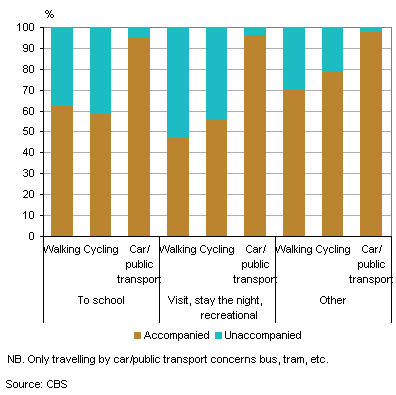Most young children do not travel unaccompanied

Three quarters of children aged between 4 and 12 did not travel unaccompanied in 2010. Children older than 12 were usually allowed to travel alone over shorter distances. Irrespective of age, children are usually accompanied when travelling over longer distances. If children go to school, visit friends or participate in out-of-school activities, they often travel alone.
Children allowed to travel alone over shorter distances
Within a radius of 500 metres, children are allowed to travel alone in more than half of cases. If they go further away, the proportion of them allowed to travel alone diminishes rapidly. Over distances exceeding 2.5 km, only 10 percent are allowed to travel alone. For children aged 4 or 5 years distance hardly matters: even if the distance is only 500 m, they are nearly always accompanied by an older person. Three quarters of children in the age category 9-12 are allowed to go alone in this case.
Children travelling in the company of at least one person older than 12 by distance and age, 2010

On foot and by bicycle
When children travelled alone in 2010, it was usually to go to school, a club or to play with friends. Nearly one third of children went alone to one of these destinations. When going to other destinations, only 14 percent travelled unaccompanied. Children are mostly accompanied by one of their parents, if they go shopping or go to the GP, dentist of hairdresser.
If children have to go somewhere, they walk or cycle six out of ten times. If they go to play with friends, they are more often alone than if they walk to school. Going somewhere unaccompanied usually takes place during the daytime. After 7 pm only 18 percent of children are allowed to go out alone versus 28 percent before 5 pm.
Children travelling in the company of at least one person older than 12 by motive and means of transport, 2010

Jacqueline van Beuningen and Ilona Bouhuijs